Descending an Antarctic Crevasse
Descending into the ice on a line and harness wasn’t on my 2025 bingo card.
Flags are a big deal at Rothera. Not the Union Flag—though one does fly above the station—but the black and red bamboo markers that stand proudly around station. They indicate Important Things: the edge of a building hidden beneath deep snow, or the line you Must Stay Within. These visual cues anre essential in an environment where the ground is often covered, and where glaciers are so active you can almost see their movement. Nowhere is this boundary more crucial than at the edge of the ‘flagline’—the perimeter that separates Rothera from the mostly unknown terrain beyond. On the southern side, it marks a safe distance from the cliffs bordering the sea; to the north, it draws a line between solid ground and heavily crevassed glacier. Inside the flags is considered safe—often good skiing territory, even. Beyond them, you need training, equipment, and a guide.
This week, I had the chance to go beyond.
We set off on Monday morning. Jono, my Field Guide, and I made our way up the short ramp that leads to the top of the station’s boundary. Though it was after 10 a.m., the sun had only recently cleared the horizon. Its low angle cast a soft golden light over the hillside, brushing the jagged mountain peaks in soft tones. The air, uncharacteristically windless, let us feel a small trace of radiated heat.
At the top of the ramp, we paused to rope up. We unpacked ice axes, checked harnesses, clipped carabiners. The line of flags marked the edge of station territory. Beyond them lay the glacier, and the reason we were here: crevasses.
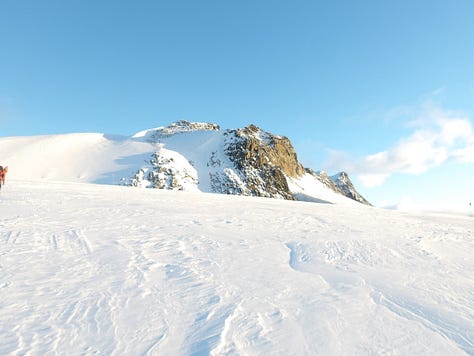
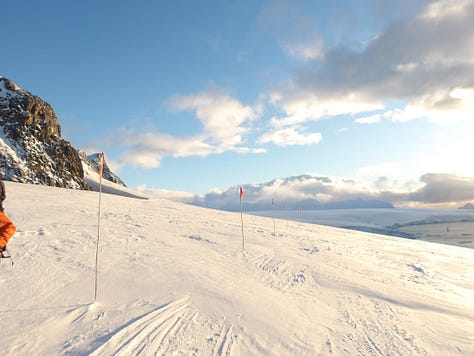
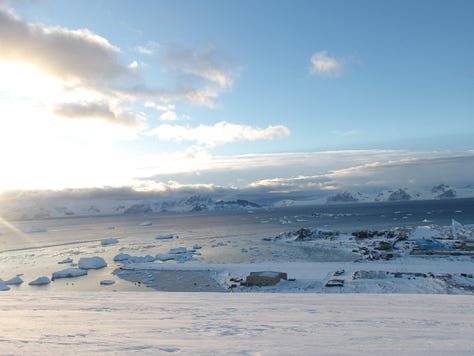
Travel outside the flagline is usually all about avoiding these deep, unseen cracks in the ice. This time, however, we were going looking for one. Tethered to each other by rope, we walked several metres apart—enough to maintain tension, so that if one of us were to fall into a crevasse (euphemistically referred to as a “slot” or “hole”), the other has the best chance possible to halt the fall. The idea is not to fall at all. Comfortingly, we weren’t the first to visit this particular crevasse via this route—others had been here already that day.
When we arrived on site, the location was… underwhelming. From the surface, the snow looked identical to everything around it—white, undisturbed, flat. But somewhere below was a void. We set up our anchor point several metres back from the presumed edge: four steel stakes driven into the snow in a specific configuration, then connected into a single master point with slings and carabiners. This was our fixed line—our safeguard. Clipped into it, we could move about freely with security against a fall that doesn’t rely on the someone digging their feet in.
Moving from the anchor to the suspected crevasse location was slow and cautious. With an articulated metal probe in hand, I stepped backwards across the snow, stabbing into the surface to feel for hollow space beneath. I was attached by a belay system and a prusik—a backup friction knot that would stop a fall if the primary system failed. At last, the probe struck air. We’d found our target.
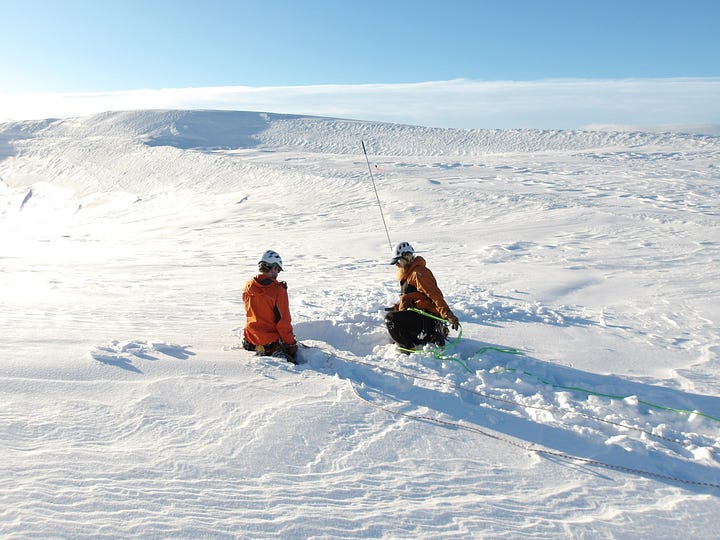
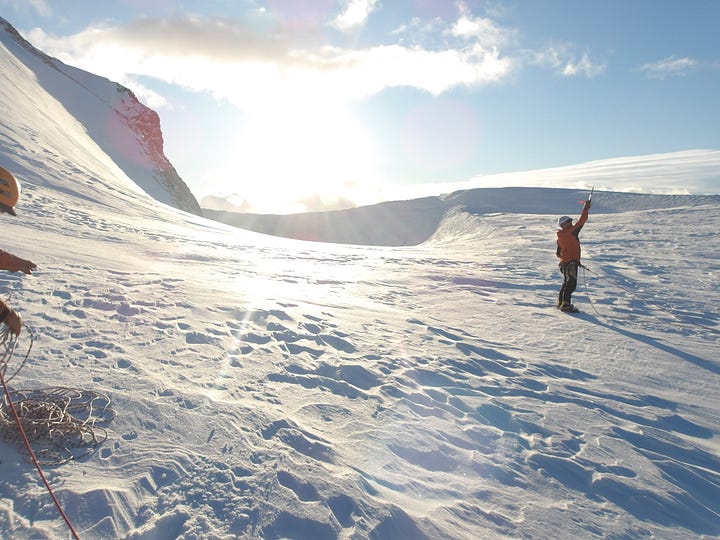

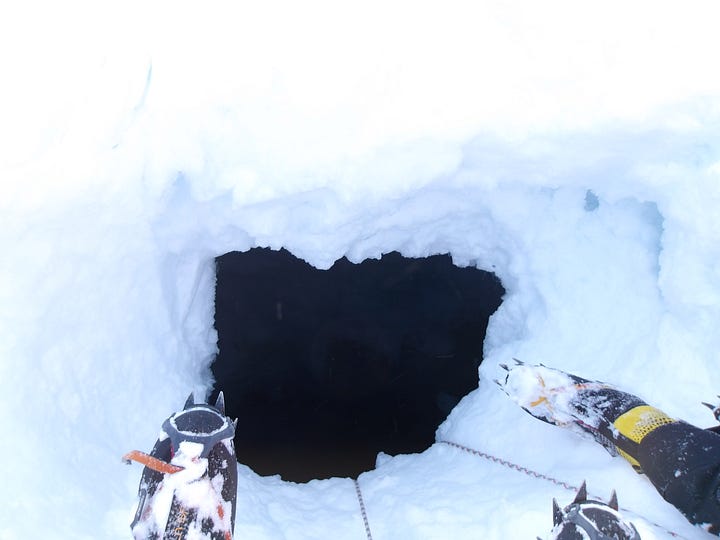
Digging through the snow took time. We cleared down nearly two metres, carving out a narrow ramp until the solid white surface gave way to the darker and harder glacial ice. Widening the hole slightly revealed a crevasse about 25 metres deep and a few metres across.
It doesn’t take much gear to abseil safely. We used a belay device—essentially a mechanical brake that manages friction on the rope—and a prusik knot for backup. The rope slides through the device smoothly when you lift slightly, and locks when you let go. Since I’m relatively new to climbing, the added friction of the prusik was reassuring. Jono talked me through the descent one final time, then went first, disappearing into the ground. Close to the bottom, he drove two ice screws into a ledge and secured himself. Then it was my turn.
Before I do something daunting, I usually find comfort in reminding myself that I’ve handled harder and scarier situations before—rough days at sea, difficult manoeuvres, public speaking under pressure. It works well enough. But this time, I wasn’t sure that anything I’d done really compared to lowering myself into a hole in the ice.
I tested my harness and belay system one final time. It held. Deep breath. With both hands locked on the rope, I slid down the steep hole into the void. My body pivoted 180º at the opening as I turned to face the nearest wall, using my feet to brace against the ice. Every step down was deliberate. I searched for purchase with my crampons, nudging into the icy surface for friction.
The inside of a crevasse is unlike anywhere I’ve ever been. The walls are solid glacial ice—dense, blue, and cold to the touch. They’re not smooth, but ridged and pocked with ledges, their imperfection belying the incredible force originally imposed to tear the ice apart. Icicles, many over a metre long, hung from the overhangs like the stems of wine glasses. They form as melting snow trickles down the inside walls and refreezes. Little of that water reaches the bottom—just enough to create a slushy channel forming a static river. The light inside the crevasse filters through the thinner patches of snow above, refracting in shades of blue that glow with an other-worldly, underwater quality.
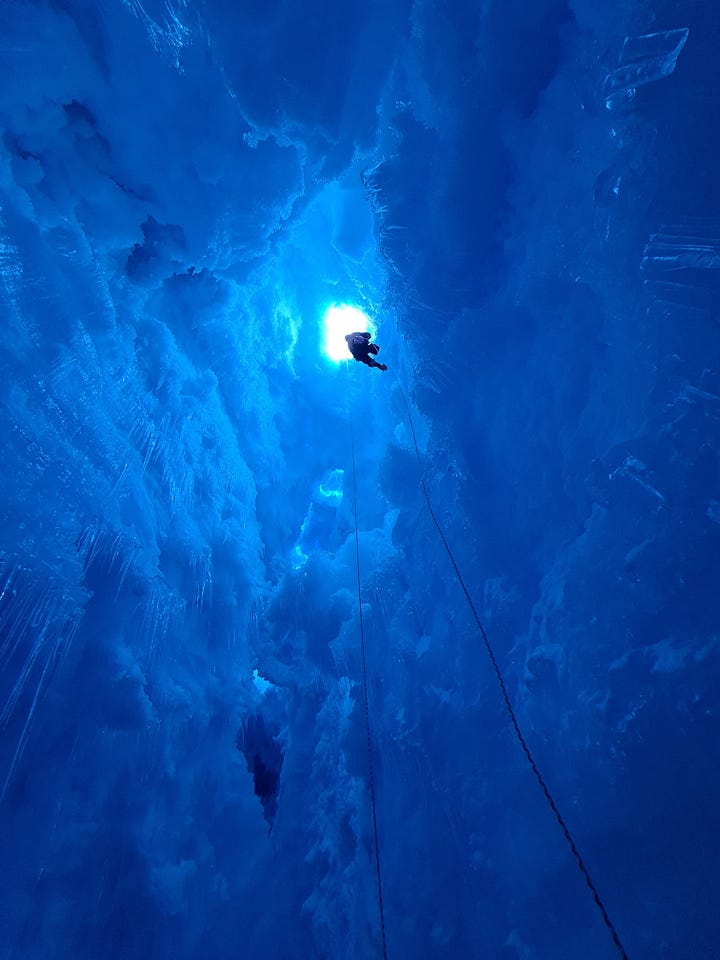
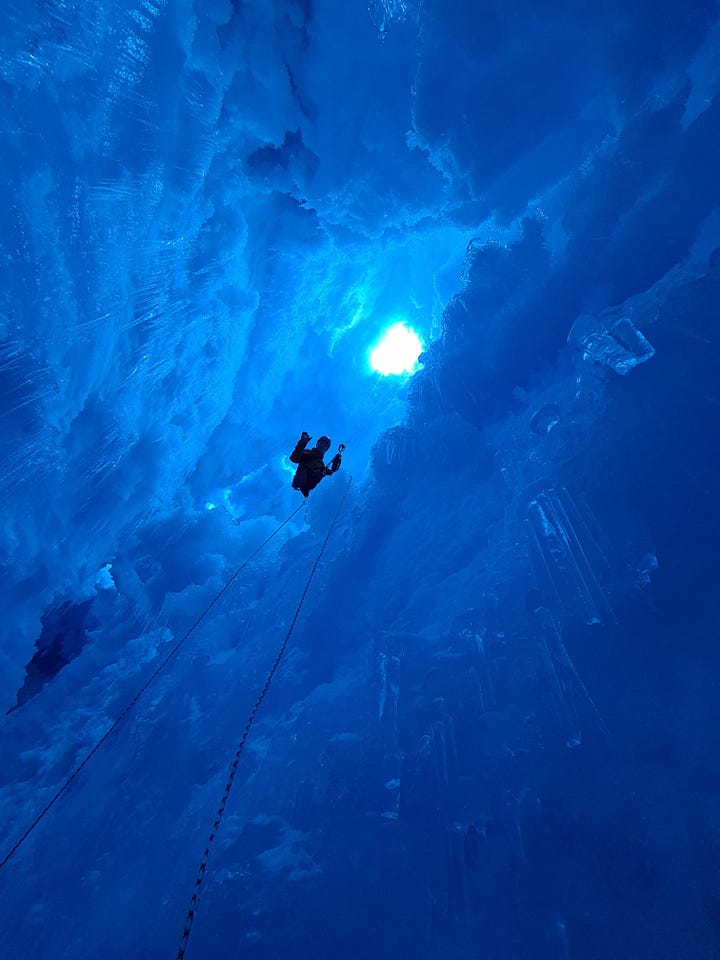

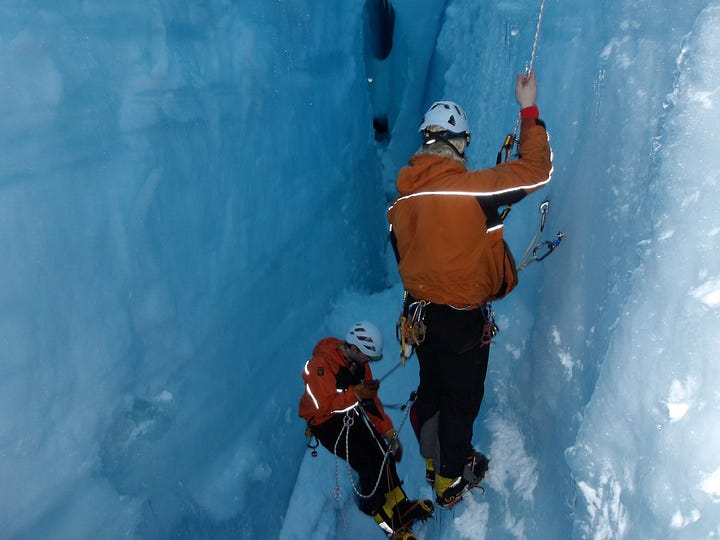
At the ledge, I took a moment to look up. The opening, which had felt reasonable from the surface, now looked like a pinprick of light. Though the crevasse was wide enough to move freely—maybe six to eight feet across—the angles of ice and rock and snow created a sense of compression. The air felt cold, heavy, and close. The ledge beneath my boots felt solid, but temporary. I felt immense satisfaction having made the descent, but little incentive to spend a long within the crevasse’s confines.
The weather was due to deteriorate and we wanted to beat it. Nearly as soon as we were in, we began preparing to leave. To ascend, we used two mechanical ascenders, a loop for one foot, and a clove hitch as backup. The process is methodical: lift one ascender, stand up into the rope, then advance the second. Each movement gains only a small amount of height for a lot of effort, but it’s reliable. I climbed carefully, conscious not send ice hurtling down below. The hardest part was the final few metres—hauling out through the narrow entrance where the rope dragged tight across the edge. I ended up using a pulley system for assistance. It’s much easier when someone just drags you out.
Packing down was faster than setting up. Within minutes of climbing out, we’d dismantled the anchors, stowed the abseiling line, and roped back up. With the crevasse behind us, we began the slow walk north, heading for our first night in the field.




